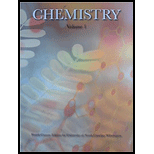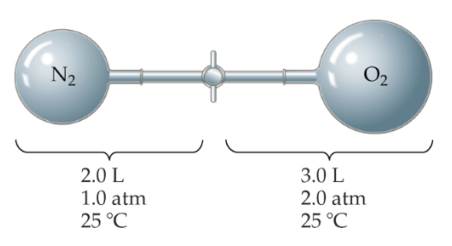
CHM 101 VOL 1 2014 >IC<
17th Edition
ISBN: 9781269932905
Author: Pearson
Publisher: PEARSON C
expand_more
expand_more
format_list_bulleted
Concept explainers
Textbook Question
Chapter 10, Problem 61E
Consider the apparatus shown in the following drawing.
a. When the valve between the two containers is opened and gases are allowed to mix, how does the valve occupied by the N2 gas change ? What is the partial pressure of N2 after mixing?
b. How does the volume of the O2 gas change when the gases mix? What is the partial pressure of O2 in the mixture?
c. What is the total pressure in the container after the gases mix?

Expert Solution & Answer
Want to see the full answer?
Check out a sample textbook solution
Chapter 10 Solutions
CHM 101 VOL 1 2014 >IC<
Ch. 10.2 - Prob. 10.1.1PECh. 10.2 -
Gallium melts just above room temperature...Ch. 10.2 - Prob. 10.2.1PECh. 10.2 - Prob. 10.2.2PECh. 10.3 - Prob. 10.3.1PECh. 10.3 - Prob. 10.3.2PECh. 10.4 - Prob. 10.4.1PECh. 10.4 - Prob. 10.4.2PECh. 10.4 - Prob. 10.5.1PECh. 10.4 - Prob. 10.5.2PE
Ch. 10.4 - Prob. 10.6.1PECh. 10.4 - Prob. 10.6.2PECh. 10.5 - Prob. 10.7.1PECh. 10.5 - Prob. 10.7.2PECh. 10.5 - Prob. 10.8.1PECh. 10.5 - Prob. 10.8.2PECh. 10.5 - Prob. 10.9.1PECh. 10.5 - Prob. 10.9.2PECh. 10.6 - Prob. 10.10.1PECh. 10.6 - Prob. 10.10.2PECh. 10.6 - Prob. 10.11.1PECh. 10.6 - Prob. 10.11.2PECh. 10.7 - Prob. 10.12.1PECh. 10.7 - Prob. 10.12.2PECh. 10.8 - Fill in the blanks for the following statement:...Ch. 10.8 - Prob. 10.13.2PECh. 10.8 - Prob. 10.14.1PECh. 10.8 - Prob. 10.14.2PECh. 10.9 - Calculate the pressure of a 2975-mol sample of N2...Ch. 10.9 - Prob. 10.15.2PECh. 10 - Prob. 1DECh. 10 - Prob. 1ECh. 10 - Prob. 2ECh. 10 - Consider the sample of gas depicted here_ What...Ch. 10 - Imagine that the reaction 2CO(g)+O2(g)2CO(g)...Ch. 10 - Suppose you have a fixed amount of an ideal gas at...Ch. 10 - Prob. 6ECh. 10 - Prob. 7ECh. 10 - Prob. 8ECh. 10 - Prob. 9ECh. 10 - Prob. 10ECh. 10 -
10.11 A thin glass tube 1 m long is filled with...Ch. 10 -
10.12 The graph below shows the change in...Ch. 10 - Prob. 13ECh. 10 - Prob. 14ECh. 10 - Prob. 15ECh. 10 - Prob. 16ECh. 10 - Prob. 17ECh. 10 - a. The compound 1-iodododecane is a nonvolatile...Ch. 10 - Prob. 19ECh. 10 - Prob. 20ECh. 10 - Prob. 21ECh. 10 - Prob. 22ECh. 10 - Prob. 23ECh. 10 - Prob. 24ECh. 10 - You have a gas at 25C confined to a cylinder with...Ch. 10 - Prob. 26ECh. 10 - Prob. 27ECh. 10 - Nitrogen and hydrogen gases react to form ammonia...Ch. 10 -
10.29
a. What conditions are represented by the...Ch. 10 - Prob. 30ECh. 10 - Prob. 31ECh. 10 - Prob. 32ECh. 10 - Prob. 33ECh. 10 - Prob. 34ECh. 10 - Prob. 35ECh. 10 - Prob. 36ECh. 10 - Calculate the number of molecules in deep breath...Ch. 10 - If the pressure exerted by ozone, O3, in the...Ch. 10 - A scuba diver’s tank contain 0.29 kg of O2...Ch. 10 - Prob. 40ECh. 10 - Prob. 41ECh. 10 - Prob. 42ECh. 10 - Chlorine is widely used to purify municipal water...Ch. 10 - Many gases are shipped in high-pressure...Ch. 10 - Prob. 45ECh. 10 - Prob. 46ECh. 10 - Rank the following gases from least to denser at...Ch. 10 - Prob. 48ECh. 10 - Prob. 49ECh. 10 - Prob. 50ECh. 10 - Prob. 51ECh. 10 - Prob. 52ECh. 10 - Prob. 53ECh. 10 - Prob. 54ECh. 10 - Magnesium can be used as a ‘getter” in evacuated...Ch. 10 - Prob. 56ECh. 10 - The metabolic oxidation of glucose, C6H12O6, in...Ch. 10 - Prob. 58ECh. 10 - Prob. 59ECh. 10 - Prob. 60ECh. 10 - Consider the apparatus shown in the following...Ch. 10 - Prob. 62ECh. 10 - A mixture containing 0.75 mol He(g), 0.330 mol...Ch. 10 - A deep-sea diver uses a gas cylinder with a volume...Ch. 10 - Prob. 65ECh. 10 - Prob. 66ECh. 10 - Prob. 67ECh. 10 - Prob. 68ECh. 10 - Prob. 69ECh. 10 - Prob. 70ECh. 10 - Prob. 71ECh. 10 - Prob. 72ECh. 10 - Prob. 73ECh. 10 - Prob. 74ECh. 10 - Prob. 75ECh. 10 - Indicate which of the following statement...Ch. 10 - Prob. 77ECh. 10 - Prob. 78ECh. 10 - Prob. 79ECh. 10 - Suppose you have two 1-L flasks, one containing N2...Ch. 10 - Prob. 81ECh. 10 -
10.8
Place the following gases in order of...Ch. 10 - Prob. 83ECh. 10 - Prob. 84ECh. 10 - Prob. 85ECh. 10 - Prob. 86ECh. 10 - Prob. 87ECh. 10 - Prob. 88ECh. 10 - Prob. 89ECh. 10 - Prob. 90ECh. 10 - Prob. 91ECh. 10 - Prob. 92ECh. 10 - Prob. 93ECh. 10 - Prob. 94ECh. 10 - Prob. 95ECh. 10 - Prob. 96ECh. 10 - Prob. 97AECh. 10 - A gas bubble with a volume of 1.0 mm3 originates...Ch. 10 - A 15.0-L tank is filled with helium gas at a...Ch. 10 - Prob. 100AECh. 10 - Prob. 101AECh. 10 - Prob. 102AECh. 10 - Prob. 103AECh. 10 - Prob. 104AECh. 10 - Prob. 105AECh. 10 - Prob. 106AECh. 10 - Prob. 107AECh. 10 - Prob. 108AECh. 10 - Prob. 109AECh. 10 - The density of gas of unknown molar mass was...Ch. 10 - A glass vessel fitted with a stopcock valve has a...Ch. 10 - Prob. 112AECh. 10 -
10.113 consider the following gases. All at STP:...Ch. 10 - Prob. 114AECh. 10 - Prob. 115AECh. 10 - Prob. 116AECh. 10 - Prob. 117AECh. 10 - Prob. 118IECh. 10 - Prob. 119IECh. 10 - Prob. 120IECh. 10 -
10.121 A 4.00-g sample of a mixture of CaO and...Ch. 10 - Prob. 122IECh. 10 - Prob. 123IECh. 10 - Chlorine dioxide gas (CIO2) is used as a...Ch. 10 - Natural gas is very abundant in many Middle...Ch. 10 - Prob. 126IECh. 10 - Prob. 127IE
Knowledge Booster
Learn more about
Need a deep-dive on the concept behind this application? Look no further. Learn more about this topic, chemistry and related others by exploring similar questions and additional content below.Similar questions
- If equal masses of O2 and N2 are placed in separate containers of equal volume at the same temperature, which of the following statements is true? If false, explain why it is false. (a) The pressure in the flask containing N2 is greater than that in the flask containing O2. (b) There are more molecules in the flask containing O2 than in the flask containing N2.arrow_forwardAnswer the following questions: (a) If XX behaved as an ideal gas, what would its graph of Z vs. P look like? (b) For most of this chapter, we performed calculations treating gases as ideal. Was this justified? (c) What is the effect of the volume of gas molecules on Z? Under what conditions is this effect small? When is it large? Explain using an appropriate diagram. (d) What is the effect of intermolecular attractions on the value of Z? Under what conditions is this effect small? When is it large? Explain using an appropriate diagram. (e) In general, under what temperature conditions would you expect Z to have the largest deviations from the Z for an ideal gas?arrow_forwardWhich of the following statements is(are) true? a. If the number of moles of a gas is doubled, the volume will double, assuming the pressure and temperature of the gas remain constant. b. If the temperature of a gas increases from 25C to 50C, the volume of the gas would double, assuming that the pressure and the number of moles of gas remain constant. c. The device that measures atmospheric pressure is called a barometer. d. If the volume of a gas decreases by one half, then the pressure would double, assuming that the number of moles and the temperature of the gas remain constant.arrow_forward
- A study of climbers who reached the summit of Mount Everest without supplemental oxygen showed that the partial pressures of O2 and CO2 in their lungs were 35 mm Mg and 7.5 mm Hg, respectively. The barometric pressure at the summit was 253 mm Hg. Assume the lung gases are saturated with moisture at a body temperature of 37 C [which means the partial pressure of water vapor in the lungs is P(H2O) = 47.1 mm Hg]. If you assume the lung gases consist of only O2, N2, CO2, and H2O, what is the partial pressure of N2?arrow_forwardIn the Mthode Champenoise, grape juice is fermented in a wine bottle to produce sparkling wine. The reaction is C6H12O6(aq)2C2H5OH(aq)+2CO2(g) Fermentation of 750. mL grape juice (density = 1.0 g/cm3) is allowed to take place in a bottle with a total volume of 825 mL until 12% by volume is ethanol (C2H5OH). Assuming that the CO2 is insoluble in H2O (actually, a wrong assumption), what would be the pressure of CO2 inside the wine bottle at 25C? (The density of ethanol is 0.79 g/cm3.)arrow_forwardA new boron hydride, BxHy, has been isolated. To find its molar mass, you measure the pressure of the gas in a known volume at a known temperature. The following experimental data are collected: Mass of gas = 12.5 mg Pressure of gas = 24.8 mm Hg Temperature = 25 C Volume of flask = 125 mL Which formula corresponds to the calculated molar mass? (a) B2H6 (b) B4H10 (c) B5H9 (d) B6H10 (e) Bl0H14arrow_forward
arrow_back_ios
arrow_forward_ios
Recommended textbooks for you
 ChemistryChemistryISBN:9781305957404Author:Steven S. Zumdahl, Susan A. Zumdahl, Donald J. DeCostePublisher:Cengage Learning
ChemistryChemistryISBN:9781305957404Author:Steven S. Zumdahl, Susan A. Zumdahl, Donald J. DeCostePublisher:Cengage Learning
 Chemistry for Engineering StudentsChemistryISBN:9781337398909Author:Lawrence S. Brown, Tom HolmePublisher:Cengage Learning
Chemistry for Engineering StudentsChemistryISBN:9781337398909Author:Lawrence S. Brown, Tom HolmePublisher:Cengage Learning Chemistry: Principles and ReactionsChemistryISBN:9781305079373Author:William L. Masterton, Cecile N. HurleyPublisher:Cengage LearningChemistry: Matter and ChangeChemistryISBN:9780078746376Author:Dinah Zike, Laurel Dingrando, Nicholas Hainen, Cheryl WistromPublisher:Glencoe/McGraw-Hill School Pub Co
Chemistry: Principles and ReactionsChemistryISBN:9781305079373Author:William L. Masterton, Cecile N. HurleyPublisher:Cengage LearningChemistry: Matter and ChangeChemistryISBN:9780078746376Author:Dinah Zike, Laurel Dingrando, Nicholas Hainen, Cheryl WistromPublisher:Glencoe/McGraw-Hill School Pub Co Chemistry for Engineering StudentsChemistryISBN:9781285199023Author:Lawrence S. Brown, Tom HolmePublisher:Cengage Learning
Chemistry for Engineering StudentsChemistryISBN:9781285199023Author:Lawrence S. Brown, Tom HolmePublisher:Cengage Learning

Chemistry
Chemistry
ISBN:9781305957404
Author:Steven S. Zumdahl, Susan A. Zumdahl, Donald J. DeCoste
Publisher:Cengage Learning


Chemistry for Engineering Students
Chemistry
ISBN:9781337398909
Author:Lawrence S. Brown, Tom Holme
Publisher:Cengage Learning

Chemistry: Principles and Reactions
Chemistry
ISBN:9781305079373
Author:William L. Masterton, Cecile N. Hurley
Publisher:Cengage Learning

Chemistry: Matter and Change
Chemistry
ISBN:9780078746376
Author:Dinah Zike, Laurel Dingrando, Nicholas Hainen, Cheryl Wistrom
Publisher:Glencoe/McGraw-Hill School Pub Co

Chemistry for Engineering Students
Chemistry
ISBN:9781285199023
Author:Lawrence S. Brown, Tom Holme
Publisher:Cengage Learning
Step by Step Stoichiometry Practice Problems | How to Pass ChemistryMole Conversions Made Easy: How to Convert Between Grams and Moles; Author: Ketzbook;https://www.youtube.com/watch?v=b2raanVWU6c;License: Standard YouTube License, CC-BY